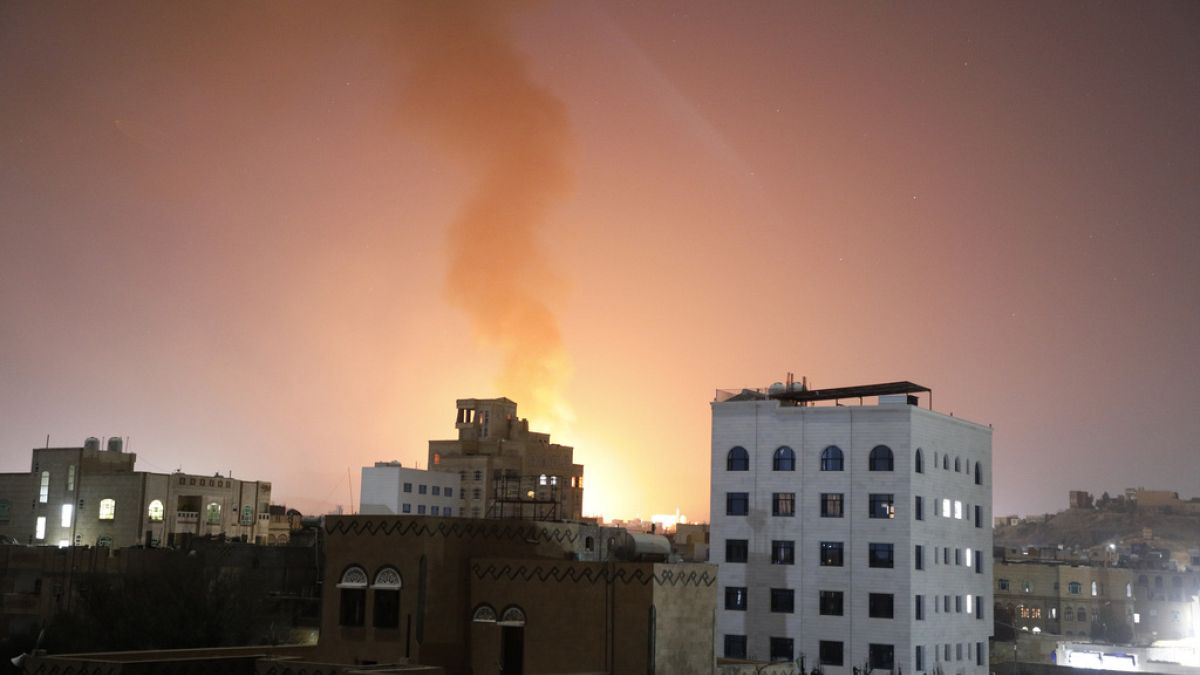
According to US officials, American and British fighter jets hit sites in eight locations, targeting missiles, launchers, rockets, drones and air defence systems. The officials spoke on condition of anonymity in order to provide early details of an ongoing military operation.
This is the fourth time that the US and British militaries have conducted a combined operation against the Houthis since Jan. 12. But the US has also been carrying out almost daily strikes to take out Houthi targets, including incoming missiles and drones aimed at ships, as well as weapons that were prepared to launch.
The US F/A-18 fighter jets launched from the USS Dwight D. Eisenhower aircraft carrier, which is currently in the Red Sea, officials said.
“The United States will not hesitate to take action, as needed, to defend lives and the free flow of commerce in one of the world’s most critical waterways,” said US Defence Secretary Lloyd Austin. “We will continue to make clear to the Houthis that they will bear the consequences if they do not stop their illegal attacks.”
The Houthis denounced the “US-British aggression” and vowed to keep up its military operation in response. “The Yemeni Armed Forces affirm that they will confront the US-British escalation with more qualitative military operations against all hostile targets in the Red and Arabian Seas in defence of our country, our people and our nation,” it said in a statement.
The US, UK, and other allies said in a statement the “necessary and proportionate strikes specifically targeted 18 Houthi targets across 8 locations in Yemen” that also included underground storage facilities, radar and a helicopter.
UK Defence Secretary Grant Shapps said RAF Typhoon jets engaged in “precision strikes” aimed at degrading Houthi drones and launchers. Shapps said it came after “severe Houthi attacks against commercial ships in the Red Sea and Gulf of Aden, including against the British-owned MV Islander and the MV Rubymar, which forced the crew to abandon ship.” It’s the fourth time Britain has joined in the US-led strikes.
The strikes have support from the wider coalition, which includes Australia, Bahrain, Canada, Denmark, the Netherlands and New Zealand.
President Joe Biden and other senior leaders have repeatedly warned that the US won’t tolerate the Houthi attacks against commercial shipping. But the counterattacks haven’t appeared to diminish the Houthis’ campaign against shipping in the region, which the militants say is over Israel’s war against Hamas in the Gaza Strip.
“Our aim remains to de-escalate tensions and restore stability in the Red Sea, but we will once again reiterate our warning to Houthi leadership: we will not hesitate to continue to defend lives and the free flow of commerce in the face of continued threats,” said the Saturday statement.
The Houthis have launched at least 57 attacks on commercial and military ships in the the Red Sea and Gulf of Aden since Nov. 19, and the pace has picked up in recent days.
“We’ve certainly seen in the past 48, 72 hours an increase in attacks from the Houthis,” Pentagon spokeswoman Sabrina Singh said in a briefing Thursday. And she acknowledged that the Houthis have not been deterred.
“We never said we’ve wiped off the map all of their capabilities,” she told reporters. “We know that the Houthis maintain a large arsenal. They are very capable. They have sophisticated weapons, and that’s because they continue to get them from Iran.”
There have been at least 32 US strikes in Yemen over the past month and a half; a few were conducted with allied involvement. In addition, US warships have taken out dozens of incoming missiles, rockets and drones targeting commercial and other Navy vessels.
Earlier Saturday, the destroyer USS Mason downed an anti-ship ballistic missile launched from Houthi-held areas in Yemen toward the Gulf of Aden, US Central Command said, adding that the missile was likely targeting MV Torm Thor, a US-Flagged, owned, and operated chemical and oil tanker.
The US attacks on the Houthis have targeted more than 120 launchers, more than 10 surface-to-air-missiles, 40 storage and support building, 15 drone storage building, more than 20 unmanned air, surface and underwater vehicles, several underground storage areas and a few other facilities.
The rebels’ supreme leader, Abdul Malik al-Houthi, announced this past week an “escalation in sea operations” conducted by his forces as part of what they describe as a pressure campaign to end Israel’s war on Hamas.
But while the group says the attacks are aimed at stopping that war, the Houthis’ targets have grown more random, endangering a vital waterway for cargo and energy shipments traveling from Asia and the Middle East onward to Europe.
During normal operations, about 400 commercial vessels transit the southern Red Sea at any given time. While the Houthi attacks have only actually struck a small number of vessels, the persistent targeting and near misses that have been shot down by the US and allies have prompted shipping companies to reroute their vessels from the Red Sea.
Instead, they have sent them around Africa through the Cape of Good Hope — a much longer, costlier and less efficient passage. The threats also have led the US and its allies to set up a joint mission where warships from participating nations provide a protective umbrella of air defence for ships as they travel between the Suez Canal and the Bab el-Mandeb Strait.





